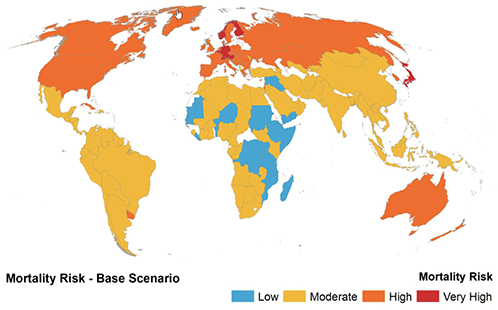
Image: Researchers generated a map to demonstrate the mortality risk of each country.
Western Sydney University researchers have used advanced statistical analysis to better understand how countries are impacted by COVID-19.
A funded collaboration with United Arab Emirates University (UAEU) allowed researchers from the University’s School of Computer, Data and Mathematical Sciences to access a range of global datasets – to determine which countries were well-equipped to fight a global pandemic.
A UAEU task force – comprised of experts in Data Science, Epidemiology, Viral Pathology/Infections and Econometrics – also collaborated on the project.
Dr Omar Mubin, alongside PhD students Mudassar Arsalan and Belal Alsinglawi, accessed global socio-economic and COVID-19 data from World Bank, NASA, Johns Hopkins University, and Environmental Systems Research Institute (ESRI).
Using the range of data-sets, the researchers assessed countries on the basis of:
- Population – including total size of population, and median age;
- Economy – including Gross Domestic Product (GDP) per capita, and current health expenditure;
- Health capacity – including the number of hospital beds, physicians and nurses available per 1000 people; and
- Density in urban areas.
COVID-19 data as of 13 May 2020 was also used as a means of assessing countries on the basis of their number of active cases; mortality rates; and the size of their ‘susceptible population’ not yet infected by COVID-19.
The results of the analysis, published in the International Journal of Environmental Research and Public Health, indicate that the countries with the highest mortality risk – due to their large ratio (and living patterns) of elderly population – include Japan, Norway, Germany, Switzerland, Austria, Belgium, Denmark, Sweden, Netherlands, and Finland.
“On 13 May 2020, most countries were at a similar or lower risk level than what would have been expected pre-COVID, with only 44 out of 153 countries experiencing a more than 20 percent increase in mortality risk,” said Dr Mubin.
“In this study, the strongest predictor of a country’s mortality risk was its ratio of elderly people – which surpassed all other socio-economic and demographic indicators.”
Dr Mubin said the study shows the benefit of taking a multi-factor, weighted approach to determining a country’s preparedness for future pandemics.







